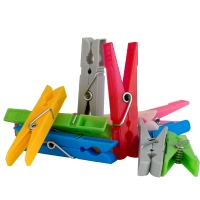 The progress of Science & Technology has given you at your finger tips the everyday objects – paper, tissue, egg box, clothes peg, tea bag, zip fasteners…many more You take these for granted. Do you know who invented these?
The progress of Science & Technology has given you at your finger tips the everyday objects – paper, tissue, egg box, clothes peg, tea bag, zip fasteners…many more You take these for granted. Do you know who invented these?
The rawlplug that millions of us use in DIY jobs every day was invented in 1910 by an Engineer called John Joseph Rawlings. He had been contracted to install electrical fittings at the British Museum with the stipulation that the walls should be damaged as little as possible. He came up with a plug made out of jute fibres that had been saturated with glue.
Fifty years later a German inventor developed a plastic plug that used the same principle of “grip by expansion”.
You have the clothes hanger, which looks very simple, but 189 patents were issued for various models between 1900 and 1906.
Wire hanger was invented when Albert Parkhouse arrived at work on a cold winter’s day to find all the coat pegs taken – so on the spot he bent a piece of wire into a hanger.
Perfect product
Dr Sue Mossman, the Science Museum material sciences specialist says the aim of the exhibition is to make people think about things that they use every day.
The idea for Hidden Heroes came from a company called Hi-Cone which makes another simple but durable product, the plastic strip used to carry six-packs of drinks.
Idiot-proof
In collaboration with the Vitra Design museum in Germany, Hi-Cone selected 36 such products and mounted the Hidden Heroes exhibition, which is now arriving in London after winning all sorts of awards.
One striking thing about an exhibition of products that are used by everyone is that only one of the hidden heroes was invented by a woman. In 1908, German housewife Melitta Bentz invented an effective coffee filter by lining a perforated metal beaker with blotting paper.
Sticky business
More recent products that already look destined for longevity include the sticky note seen plastered on computer screens, notice-boards and documents just about everywhere.
In the late 1960s, when an American scientist at 3M’s research lab, Dr Spencer Silver, was trying to develop an extra-strong adhesive. Instead, he developed a weak glue that allowed things to be joined and taken apart equally easily. A decade later Silver’s colleague Arthur Fry, irritated by paper bookmarks, decided to coat them with the weak glue. The Post-It note was born.
You will not find anything that looks remotely hi-tech in the Hidden Heroes exhibition. From paperclips to Post-It note, simple and economical products have proved that they can have lasting appeal, and make some of their inventors very wealthy.
Today’s innovators may find inspiration for the products of the future in this exhibition of the hidden heroes of the past.

131568 428296I saw a lot of web site but I believe this one has got something special in it in it 40323
879239 213946Thanks for the excellent post against your weblog, it genuinely provides me with a look about this topic.??;~.?? 940960
891556 78927Hi. Cool write-up. Theres a difficulty with the web site in chrome, and you may want to check this The browser is the marketplace chief and a big component of other folks will miss your outstanding writing due to this issue. I like your Post and I am recommend it for a Web site Award. 231730
ขอบคุณสำหรับข้อมูลเกี่ยวกับดอกไม้งานศพที่ละเอียด
กำลังค้นหาข้อมูลเรื่องนี้อยู่พอดี ถือว่าเจอบทความดีๆ เลย
ใครที่กำลังเตรียมตัวจัดงานศพให้คนสำคัญควรอ่านจริงๆ
Take a look at my webb site :: ร้านจัดดอกไม้งานศพ
740930 241027Your writing taste has been surprised me. Thank you, quite nice article. 730308
718874 779490Once I originally commented I clicked the -Notify me when new feedback are added- checkbox and now every time a remark is added I get four emails with exactly the same comment. Is there any indicates you possibly can remove me from that service? Thanks! 335926
588682 833060I genuinely enjoy seeking by means of on this web site , it holds superb articles . 480843
260019 732602Youre so cool! I dont suppose Ive learn something like this before. So good to search out any person with some exclusive thoughts on this subject. realy thanks for starting this up. this web site is one thing thats wanted on the net, somebody with a bit originality. helpful job for bringing 1 thing new to the internet! 387346
เป็นข้อมูลที่มีประโยชน์มากเรื่อง “ดอกไม้งานศพ” ช่วยอธิบายการจัด การจัดดอกไม้ ให้ตรงกับความหมาย น่าสนใจมาก ค่ะ
Check out my website: จัดดอกไม้งานศพ